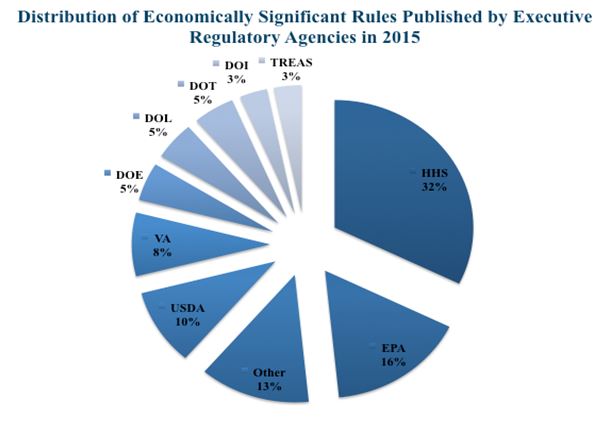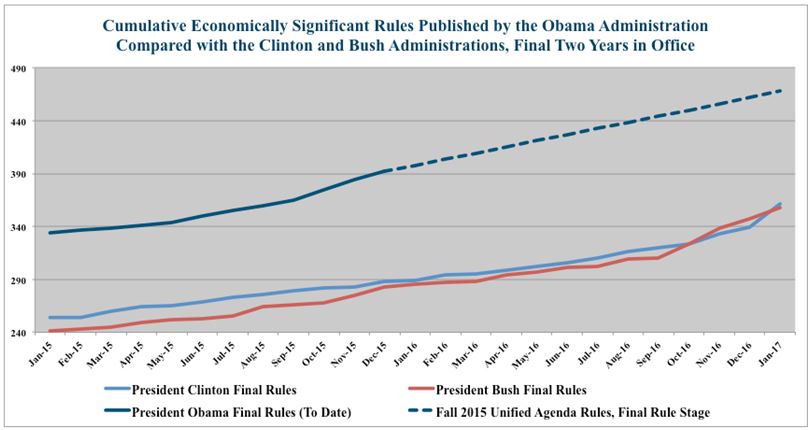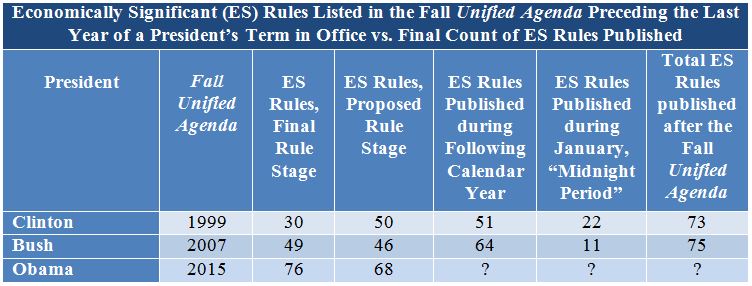In 2015, President Obama’s executive agencies issued 62 economically significant rules—those defined in Executive Order 12866 as likely to have “an annual effect on the economy of $100 million or more,” making last year the second most active regulatory year of his presidency. Many of these rules focused on his regulatory priorities, including stricter environmental standards and implementation of the Affordable Care Act (ACA) and the Dodd-Frank Wall Street Reform. This commentary looks back at the number of regulations published in 2015 and ahead to 2016, evaluating the President’s activity in the context of regulatory output of previous administrations.
Regulatory Output in 2015
According to the government database at Reginfo.gov, executive agencies issued 62 economically significant final rules in 2015. To put this number in context, these agencies under Presidents Clinton and Bush published 36 and 44 economically significant rules, respectively, during their second-to-last years in office.
From the beginning of his term until the end of December 2015, executive agencies had published 392 economically significant final rules, surpassing the total number published during the entire terms of the Bush Administration (358) by the end of August and the Clinton Administration (361) by September. Additionally, President Obama averaged a rate of 5.2 economically significant rules per month in 2015, compared to President Clinton’s rate of 3 per month and President Bush’s rate of 3.6 in their penultimate years.

The Department of Health and Human Services (HHS) was the most active, with 20 economically significant rules—the majority of which—16, implemented aspects of the ACA. This brings the total number of economically significant rules passed under the ACA to 98, with many more still required for implementation of the law. The Environmental Protection Agency (EPA) published 10 rules, including its final rule for the Clean Power Plan.

Rules Listed in the Unified Agenda as Slated for Publication in 2016
The latest Unified Agenda, published on November 19, 2015, lists 76* economically significant rules that agencies plan to publish in final form over the next 12 months. Among these there are 7 U.S. Department of Agriculture (USDA) rules, 27 HHS rules, and 10 Department of Energy (DOE) rules—predominantly regarding stricter energy conservation and efficiency standards for consumer products. Assuming that regulatory agencies publish all of these rules, it would bring President Obama’s 8-year regulatory total to 468 economically significant rules.
The ultimate count could be lower, if agencies do not complete the priorities as anticipated, however, this may be a conservative estimate of the final tally for the Obama Administration. The Agenda may not include regulations expected more than 12 months out (after the November election). Presidents have historically published more rules than those forecast by the Unified Agenda during their last year in office as they work to push through the last measures of their regulatory agendas.

Regulatory Output is Likely to Increase in 2016
Historically, regulatory agencies have dramatically increased the pace of their rulemaking as they rush to publish rules to finalize their regulatory agenda before the clock strikes midnight on their tenure in office. President Clinton’s fall 1999 Agenda forecast 30 economically significant rules, yet his administration published 73 before he left office—22 of which were published just in the month of January, right before President Bush began his presidency. President Bush’s 2007 fall agenda identified 49 upcoming final economically significant rules, but executive agencies actually published 75 before the end of his administration.

Thus, though the Unified Agenda is the most reliable source available for forecasting regulatory activity, it only predicted 41% of the regulatory activity that occurred during the remainder of the Clinton Administration and only 65% of the Bush Administration’s final regulatory output.
If this administration follows the historical trend, then 2016 and the following January before the next president takes office are likely to leave the Obama Administration with a final count of economically significant regulations well above 468.
* On 2/24/16 we updated this figure to 95 to reflect the addition of a subset of rules that were not originally included due to their appearance in the Unified Agenda as in "proposed rule stage." However, UA projections indicate that agencies intend to finalize these rules in 2016 thus increasing the total projected number of economically significant rules to 95.

